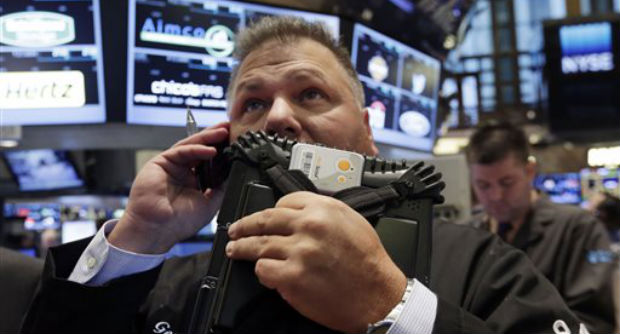US stocks hit record as Fed holds to easy-money policy

Trader George Ettinger works on the floor of the New York Stock Exchange Wednesday, Sept. 17, 2014. The Federal Reserve stuck to its slow-but-steady plans to tighten monetary policy Wednesday, disappointing so-called inflation hawks but sending US stocks to a fresh record. AP
WASHINGTON–The Federal Reserve stuck to its slow-but-steady plans to tighten monetary policy Wednesday, disappointing so-called inflation hawks but sending US stocks to a fresh record.
Amid an intensified discussion over whether the crisis-era easy-money policies are stoking asset bubbles and could unleash inflation, Fed policy makers decided the US economy will still need “unconventional” support well into next year.
After a two-day meeting, the Federal Open Market Committee led by dovish Fed Chair Janet Yellen left in place expectations for an initial rise in the federal funds rate only in mid-2015.
The benchmark rate has remained locked at 0-0.25 percent since the end of 2008, to support recovery from the Great Recession.
Yellen argued, as she has since been taking the lead at the Fed in February, that there remains too much slack in the labor market despite the fall in the US unemployment rate to 6.1 percent.
“There is relatively little change in the assessment of the outlook by the participants in this meeting,” she said at a news conference.
“There is significant underutilization of labor resources.”
Shoring up the labor market has been the key focus of the Fed under Yellen, with the falling jobless rate masking a high level of underemployed Americans and a large number of people who have dropped out of the labor market altogether.
Nevertheless, the FOMC showed a slight hawkish turn, with more members than ever agreeing that a rate increase will happen next year. Their median forecast for the fed funds at the end of the year was 1.375 percent, 0.25 percentage point more than the June median.
That suggests, too, a sharper rise in US interest rates to come when they do start.
Markets had been on the watch to see if the FOMC would change its language for signaling policy, particularly the repeated statement that any rate increase would take place only a “considerable time” after the October end to the Fed’s bond-buying stimulus program.
That phrase has been important in managing expectations for a rate rise, but critics say it binds the Fed’s hands if the economy and inflation accelerate more than forecast.
Yellen though pointed out that the FOMC lowered its growth expectations for next year to just 2.6-3.0 percent, slower than the 3.0-3.2 percent level they forecast three months ago.
And its inflation expectations remain at or below the FOMC’s 2.0 percent target for the next three years.
Even so, two FOMC members, both known hawks, voted against the policy statement.
One argued that the “considerable time” phrase reduces policy flexibility, and the other said that the economy is improving and that the ultra-low rate policy is helping pump up stocks and other assets to unreasonable levels.
The latter point was made on Sunday by the Bank for International Settlements, known as the central bank for central banks.
Claudio Borio, who heads the BIS’s monetary and economic unit, said loose monetary policies world-wide have created an “illusion of permanent liquidity” that is spurring investors to make risky bets and push up asset prices.
Yellen took pains to stress that policy would adapt to any changes in the economy.
“And as I have said repeatedly, the decisions that the committee makes about what is the appropriate time to begin to raise its target for the federal funds rate will be data-dependent,” she said.
“If the pace of progress in achieving our goals were to quicken… it is likely that the committee would begin raising its target for the federal funds rate sooner than is now anticipated.”
For the most part, though, US markets embraced the promise of continued cheap money.
The Dow Jones Industrial Average pushed to a new record high following the Fed policy announcement, adding 0.2 percent to 17,156.85, breaking the prior record close by about 18 points.
The S&P 500 gained 0.1 percent, shy of its all-time record set on September 5.
The dollar, little-changed ahead of the Fed statement, gained 0.7 percent on the euro, to trade at $1.2867 per euro.–Paul Handley